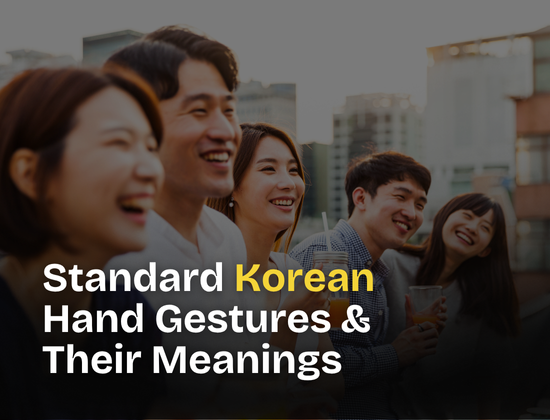
Standard Korean Hand Gestures and Their Meanings
.
Hand gestures are a powerful part of communication—often speaking louder than words. In Korean culture, body language plays a subtle yet significant role in how emotions, respect, affection, and social hierarchy are expressed. Whether you’re learning the Korean language, planning a trip to Seoul, or just a fan of K-dramas, understanding these gestures can help you connect more authentically with Korean culture.
Here's a closer look at some of the most common Korean hand gestures and what they mean.
1. The Finger Heart
Perhaps the most iconic Korean hand gesture today, the finger heart is formed by crossing your thumb and index finger to create a tiny heart shape. Popularized by K-pop idols and actors, this gesture symbolizes love and affection. It’s playful, light-hearted, and often used in photos or fan interactions.
Where you'll see it: On red carpets, in selfies, and between friends or fans.
2. Bowing With Hands by Your Side
While not exclusively a hand gesture, the placement of your hands during a bow matters. For men, hands are usually placed at the sides; for women, hands are often clasped in front. Bowing is a core part of Korean etiquette, showing respect in greetings, farewells, and apologies.
When to use it: Meeting elders, thanking someone, saying goodbye respectfully.
3. Two-Handed Handshake or Exchange
When giving or receiving something, especially from someone older or of higher status, Koreans use both hands or support their right hand with the left at the wrist or elbow. This reflects deep respect and is rooted in Confucian values.
4. The Palms-Up Wave (Come Here)
In Korea, the gesture for “come here” is done with the palm facing downward, fingers sweeping toward the body. A Western-style upward beckon can be considered rude or inappropriate, especially when directed at elders.
Use with caution: It’s polite to avoid beckoning elders or authority figures this way.
5. Peace Sign (V Sign)
A global symbol with a local twist. In Korea, the peace sign is mostly used in photos and often accompanied by a smile or playful expression. It symbolizes cheerfulness, youthfulness, and is especially popular among teenagers and in K-culture.
6. Covering the Mouth While Laughing
Though not a hand gesture in the traditional sense, covering one’s mouth when laughing is common, especially among women. It’s seen as a sign of modesty and good manners.
Why it matters: Shows respect and control in public settings.
7. Clasped Hands or Prayer Pose (Sorry or Please)
When apologizing or asking for a favor, some people bring their hands together as if in prayer. It adds sincerity and warmth to the words being said. While more casual, it’s often seen in dramas, informal situations, or light-hearted requests.
8. Hand on Back While Pouring a Drink
In Korean dining etiquette, especially when pouring alcohol, it’s polite to pour with one hand while the other supports the pouring arm or rests on your stomach/back. This gesture shows humility and courtesy.
Tip: Always pour for others first, and use both hands when receiving a drink.
9. Showing Numbers With Fingers
Unlike in some cultures where fingers indicate numbers differently, Koreans typically show numbers 1 through 5 the same way as in the West, but 6 to 10 use more stylized finger gestures involving both hands. Learning these can be fun and useful when ordering or talking about prices.
Why it's useful: Shopping, bargaining, or learning counting games.
Want to master Korean beyond the basics?
At The Language SKOOL (TLS), we don’t just teach you words—we help you live the language. From understanding cultural gestures to building real-life fluency, our Korean courses are designed to make your learning journey practical, fun, and future-ready.
Whether you're preparing for TOPIK, diving into K-dramas, or planning a career in South Korea, we’ve got you covered.
Learn with TLS. Speak with confidence. Connect with culture.
Let Korean become second nature.












